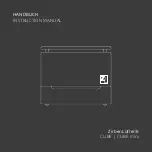
19
Instruction Book
IB019008EN October 2016 www.eaton.com
FP-25-LV-VSR
Breaker-To-Motor Starter Conversion
Section 6: Inspection and Maintenance
6.1 Introduction
WARNING
•
DO NOT WORK ON A LV-VSR IN THE “CONNECTED” POSITION.
•
DO NOT WORK ON A LV-VSR WITH SECONDARY DISCONNECTS
ENGAGED.
•
DO NOT WORK ON A LV-VSR WITH THE CONTACTOR CLOSED, UNLESS
IT IS REMOVED FROM THE SWITCHGEAR.
•
DO NOT DEFEAT ANY SAFETY INTERLOCKS.
•
FOLLOW ALL PRECAUTIONARY MEASURES WHEN TESTING FOR
VACUUM INTEGRITY.
•
FAILURE TO FOLLOW ANY OF THESE INSTRUCTIONS MAY CAUSE
DEATH, SERIOUS BODILY INJURY, OR PROPERTY DAMAGE. SEE
SECTION 2 - SAFE PRACTICES FOR MORE INFORMATION.
6.2 Frequency of Inspection
Inspect the LV-VSR once a year when operating in a clean, non-
corrosive environment. For a dusty and/or corrosive environment,
inspection should be performed twice a year. Additionally, it is
recommended to inspect the LV-VSR every time it interrupts fault
current.
The no-load life test value of the LV-VSR is hundreds of thousands
of operations. This value will be reduced if proper inspection,
maintenance, and cleaning are not performed.
Refer to Section 6.3 for maintenance and inspection check points.
6.3 Inspection and Maintenance Procedures
It is recommended that inspection and maintenance procedures are
performed outside of the cell.
CAUTION
SOME COMMERCIAL CLEANING AGENTS WILL DAMAGE THE
NAMEPLATES OR MOLDED PARTS. MAKE SURE THAT CLEANING AGENTS
OR SOLVENTS USED ARE SUITABLE FOR THE JOB.
6.3.1 V201 Contactor
NOTICE
THERE ARE NO FIELD SERVICEABLE PARTS ON CONTACTORS.
WARNING
THE ONLY WAY TO CLOSE THE CONTACTOR IS TO ENERGIZE THE COIL.
IF THE COIL IS ENERGIZED FOR THIS OR OTHER MAINTENANCE, USE
ADEQUATE CARE TO GUARD AGAINST ELECTRICAL SHOCK. DO NOT
PERFORM ANY MAINTENANCE WITH THE LV-VSR IN THE SWITCHGEAR.
6.3.2 Contact Wear Allowance
Contact material vaporizes from the contact faces during every
interruption and condenses inside the bottle. This is normal and is
provided for by over-travel or wear allowance. When the contactor
is fully closed, there is a gap between the pivot plate and the bottle
nuts. As the contacts wear, this gap decreases. When any gap
goes below 0.020 in. (0.51 mm), the unit should be replaced. Use
the 0.020 in. 0.51 mm) thick fork shaped over-travel gauge (Part
Number 7874A59H01) supplied for this measurement.
WARNING
DO NOT READJUST THE BOTTLE NUTS TO RESET OVER-TRAVEL AS THE
BOTTLES WEAR. ONCE PLACED INTO SERVICE, OVER-TRAVEL SHOULD BE
CHECKED BUT NOT ADJUSTED.
6.3.3 Mechanical Checks
WARNING
THE MECHANICAL CHECKS MAY ONLY BE PERFORMED OUTSIDE THE
SWITCHGEAR CELL.
Use a test cabinet to operate the LV-VSR. Operate the appropriate
push buttons to CLOSE and OPEN the contactor. While the
contactor is closed, observe the over-travel gap between the pivot
plates on the crossbar and the bottle nut on each pole. This over-
travel gap should be no less than 0.045 in. (1.14 mm) when the
contactor is new. If less, refer to the Contact Wear Allowance
section of this manual.
While the contactor is open, attempt to pull the armature forward.
The armature should not move because it should already be firmly
against the plastic main frame. If it does move, refer to the Kickout
Spring Adjustment section in this manual.
6.3.4 Kickout Spring Adjustment
The kickout spring is not disturbed by any maintenance described
in this manual and, therefore, should not need any adjustment.
However, when the contactor is in the OPEN position, the crossbar
should be solidly against the frame, so that it cannot move
any further open even when pulled. If kickout spring is out of
adjustment, call your closest Eaton representative.
Figure 6.1. Over-Travel Gauge





































